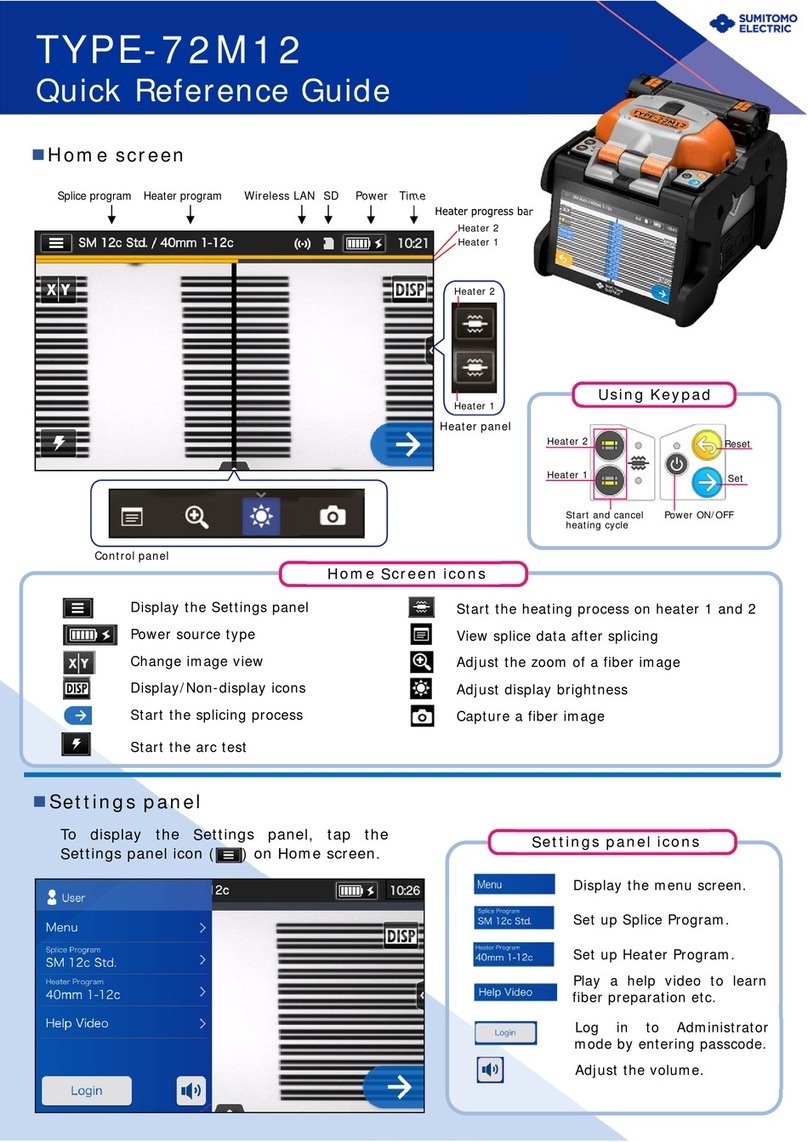
IMPORTANT : TYPE-66 SOFTWARE USER LICENSE
ATTENTION : The software installed in the TYPE-66 SPLICER (“this software”) is the property of
SUMITOMO ELECTRIC INDUSTRIES, LTD. The usage of this software is granted by a license.
CAREFULLY READ AND THIS LICENSE BEFORE USING THIS PRODUCT.
The copyright and all other rights to this software, its documentation and the writings concerning this
software (“the writings”), which contain CD-ROM, operation manual, guiding document, data tables,
command lists, writing information (photos, images, drawing, text) on appended other printed
materials, shall remain with SUMITOMO ELECTRIC INDUSTRIES, LTD. By commencing the use of
this software, you acknowledge that you have read the following license and indicate that you agree to
its terms. In case of disagreement, contact SUMITOMO ELECTRIC INDUSTRIES, LTD. or our product
supplier.
LICENSE AGREEMENT
Copyright © 2006 SUMITOMO ELECTRIC INDUSTRIES, LTD. All rights reserved.
This license is the entire agreement between SUMITOMO ELECTRIC INDUSTRIES, LTD. and you.
1. LICENSE
The following restricted rights are granted. YOU MAY :
a) use on a splicer in which this software is installed.
b) create or distribute a construction manual based on the writings on condition that you clarify
their source.
c) create an execution report of construction based on displayed information, and the writings.
d) create a document (manual or execution report) concerning the maintenance of the splicer in
which this software is installed or control its splice-quality upon displayed information and the
writings.
e) make one copy of the writings for archival or backup purpose.
2. RESTRICTIONS
The following act is forbidden on this license, except our prior written consent. YOU MAY NOT :
1) sell, distribute, rent, lease, transfer, or disclose the whole or part of the writings to the public or
unidentified parties and transfer, disclose or display the electrical format of the writings through
online media.
2) make copy of the writings except as permitted in this license.
3) reverse engineer, decompile, disassemble this software and analyze, modify or merge the
program.
3. CONTRACTING PARTIES
If you rent, lease, transfer, or resell the splicer, in which this software is installed, to a corporation or
other entity, then this agreement is formed by and between SUMITOMO ELECTRIC INDUSTRIES,
LTD. and such entity. You shall be liable for such entity to agree to the same all conditions of this
license.
4. TERM AND TERMINATION
This agreement shall continue in effect until terminated. You may terminate the agreement at
anytime by stopping the use of the splicer in which this software is installed. If you fail to comply
with any of the provision of this license, your license will be automatically terminated. Upon
termination, you shall transfer the writings to the owner of splicer (In the case that you transfer the
splicer to other corporation or entity) or return them to us, otherwise erase or destroy them by
appropriate means. You shall forever hold in confidence all trade secrets brought by this license.
Further you agree not to disclose to any third party.
5. LIMITATION OF LIABILITY
SUMITOMO ELECTRIC INDUSTRIES, LTD. and our supplier shall not be liable for consequential,
incidental or accidental damages in connection with this software or this agreement and whether
this software shall meet your special requirements, special efforts or special method beyond the
range described in the operation manual concerning this software.
6. GENERAL
If any provision of this agreement is declared by the court of competent jurisdiction to be invalid,
illegal, or unenforceable, such provision shall be severed from the agreement and the other
provisions shall remain in full force and effect.





























